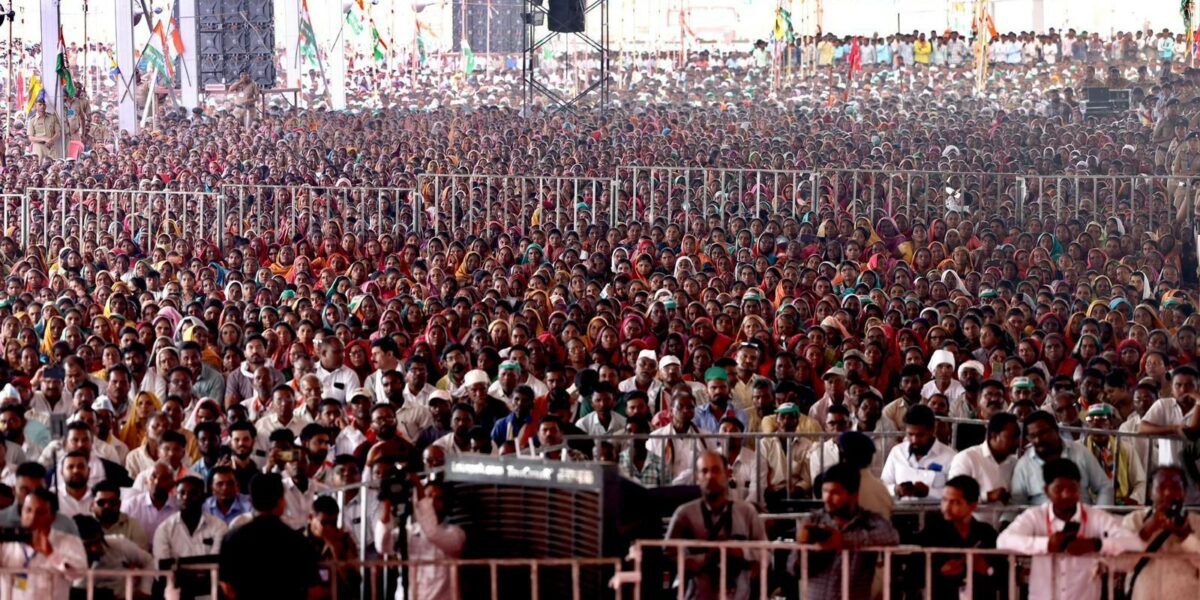This hung Parliament amplifies regional leverage, but tests claims of equidistance amid pressures for federal funds, legal shields and state development.
Published Sep 09, 2025 | 11:47 AM ⚊ Updated Sep 09, 2025 | 11:47 AM

People attending an election rally (X)
Synopsis: Regional parties like the BJD, BRS, and YSRCP claim neutrality between the BJP-led NDA and Congress-led INDIA bloc. Yet, after the 2024 Lok Sabha elections, their actions paint a picture of pragmatic manoeuvring over principled detachment.
In India’s evolving coalition era, regional parties like the Biju Janata Dal (BJD), BRS, and YSRCP claim neutrality between the BJP-led NDA and Congress-led INDIA bloc. Yet, after the 2024 Lok Sabha elections, their actions — from parliamentary votes to state negotiations — paint a picture of pragmatic manoeuvring over principled detachment.
The 2024 general elections reshaped India’s political map, with the NDA securing 293 seats but falling short of a BJP majority, forcing reliance on allies like TDP and JD(U). The INDIA bloc, with 234 seats, emerged stronger, while independents and smaller outfits such as BJD (0 seats), BRS (0 seats), and YSRCP (four seats) hold sway in the Rajya Sabha and through issue-based support.
This hung Parliament amplifies regional leverage, but tests claims of equidistance amid pressures for federal funds, legal shields and state development.
The BJD, Odisha’s dominant force until 2024, exemplifies calculated ambiguity. Founded by Naveen Patnaik in 1997, it allied with the NDA until 2009, then adopted a “equidistant” policy. Despite this, the BJD backed the NDA on over 90 percent of key bills from 2014-2024, including the Citizenship Amendment Act, farm laws, and Article 370’s abrogation — earning labels like “BJP’s B-team”.
Post-2024, after the BJP’s Odisha sweep ended Patnaik’s 24-year rule, the BJD shifted oppositional, criticising central neglect on coal royalties and special status demands. In Parliament, its nine Rajya Sabha MPs (now seven after retirements) have selectively abstained or opposed, such as on the Waqf Amendment Bill in August 2024, aligning with INDIA on minority issues.
Yet, on economic reforms like the Finance Bill, it supported the government. The ongoing Vice-Presidential election on 9 September — pitting NDA’s CP Radhakrishnan against INDIA’s B Sudershan Reddy — saw the BJD abstain, citing focus on Odisha’s welfare.
Spokesperson Sasmit Patra reiterated equidistance, but critics note that abstention indirectly aids the NDA by reducing the Opposition’s tally. Amid Patnaik’s health concerns and party rifts, whispers of NDA reconciliation persist, especially for federal aid on projects like the Polavaram irrigation scheme’s rival demands.
Overall, the BJD’s equidistance appears tactical, leaning towards NDA on national security but diverging on regional pride.
The BRS, rebranded from TRS in 2022 to eye national ambitions, has navigated a fiercer independent path. Led by former chief minister K Chandrashekar Rao (KCR), it championed Telangana statehood and federalism, winning nine Lok Sabha seats in 2019 but zero in 2024 after losing state power to Congress in 2023.
KCR’s post-poll assertion that “regional parties will play kingmaker” underscores its aversion to alliances, with working president KT Rama Rao dismissing both NDA’s “central overreach” and INDIA’s “disunity.”
In Parliament, the BRS’s eight Rajya Sabha MPs (now four) have opposed the NDA on farm distress and water disputes, such as the Krishna river sharing, while criticising Congress for unfulfilled bifurcation promises. On the Uniform Civil Code debate in late 2024, it sided with INDIA, emphasising states’ rights.
However, on anti-corruption bills, it abstained, avoiding alienation amid probes against KCR’s family in the Delhi liquor scam. The Vice-Presidential poll highlighted this: Abstention protested urea shortages, affecting Telangana farmers, with leaders joking about NOTA.
Unlike BJD, BRS lacks historical NDA ties, but merger rumours surfaced post-2024 amid legal woes — denied vehemently. At the state-level, it courts minorities and farmers, positioning against both national blocs.
This suggests genuine equidistance, rooted in survival and federal advocacy, though economic dependencies could tilt it toward negotiations.
The YSRCP, however, embodies overt pragmatism over neutrality. Launched by former chief minister YS Jagan Mohan Reddy in 2011 after splitting from Congress, it swept Andhra Pradesh in 2019 but crumbled in 2024, retaining four Lok Sabha and 11 Rajya Sabha seats amid the NDA’s state dominance.
Historical anti-Congress animosity — tied to Jagan’s father’s legacy — pushed it toward NDA support on 80 percent of votes from 2019-2024, including no-confidence motions and triple talaq bans.
Post-defeat, facing CBI cases, Jagan pledged NDA backing in the Vice-Presidential election, with MPs meeting Radhakrishnan after outreach from Rajnath Singh — snubbing sister Sharmila’s INDIA pleas.
In Parliament, it endorsed the NDA on the Andhra Reorganisation Act amendments for special status and securing funds, but criticised delays in Polavaram funding by December 2024, hinting at protests.
Yet, on the Adani controversy in early 2025, it remained silent, prioritising alliances. This NDA tilt, driven by legal and financial needs, contradicts equidistance claims, though speculation of an INDIA shift lingers if pressures mount.
In a fragmented polity, equidistance serves as a bargaining chip. BJD and BRS maintain it variably — through abstentions and selective opposition — balancing regional clout with national necessities.
YSRCP’s alignment exposes survival instincts trumping ideology. As Parliament debates key reforms, including One Nation One Election, these parties’ fluidity could redefine coalitions, underscoring federalism’s tensions in Narendra Modi’s third term.
(Views are personal. Edited by Muhammed Fazil.)
